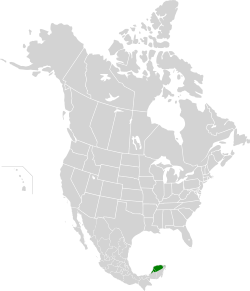Yucatán dry forests facts for kids
Quick facts for kids Yucatán dry forests |
|
|---|---|

|
|

Location of the Yucatán dry forests ecoregion
|
|
| Ecology | |
| Realm | Neotropical |
| Biome | tropical and subtropical dry broadleaf forests |
| Borders | Yucatán moist forests, Petenes mangroves and Ría Lagartos mangroves |
| Geography | |
| Area | 49,583 km2 (19,144 sq mi) |
| Country | Mexico |
| States | Campeche and Yucatán |
| Conservation | |
| Conservation status | Relatively stable/intact |
| Protected | 1,723 km2 (3%) |
The Yucatán dry forests are a special type of forest found in southern Mexico. This area is called an ecoregion, which means it's a large natural area with its own unique plants and animals. These dry forests are mostly in the northwestern part of the Yucatán Peninsula.
Contents
Where are the Yucatán Dry Forests?
These dry forests cover the northwestern part of the Yucatán Peninsula. You can find them across most of the state of Yucatán. They also stretch into the northern part of Campeche and small areas of northwestern Quintana Roo. To the east and south, they meet the Yucatán moist forests. The Gulf of Mexico is to the north and west. Along the coast, you'll see mangrove trees.
The land here is mostly flat. It sits below 400 meters (about 1,300 feet) in height. The ground is made of porous limestone and coral. This means water drains easily underground. Because of this, there are many underground caves and sinkholes. You won't find many surface streams or rivers here. The cities of Mérida and Campeche are located in this ecoregion.
What is the Climate Like?
The climate in the Yucatán dry forests is tropical and subhumid. This means it's warm all year round. It also has a long dry season. During this time, there isn't much rain. The area gets less than 1,200 millimeters (about 47 inches) of rain each year.
Amazing Plants of the Dry Forests
The main plants you'll see here are open dry forests and thorn scrub. Many trees and shrubs are deciduous. This means they lose their leaves during the long dry season. Cacti are very common, especially closer to the coast. There aren't many grassy plants or small herbs on the forest floor.
In the drier middle part of the ecoregion, two common trees are tsalam (Lysiloma bahamensis) and jabín (Piscidia piscipula). Other trees you might find include Alvaradoa amorphoides, Bursera simaruba, Cedrela mexicana, Chlorophora tinctoria, Cordia gerascanthus, and Lonchocarpus rugosus. In other areas, Vitex gaumeri, Brosimum alicastrum, Caesalpinia gaumeri, Cedrela odorata, Ceiba pentandra, and Sideroxylon foetidissimum are common.
Along the northern coast, you'll see many tall, column-shaped cacti. Some common types are Cephalocereus gaumeri, Pterocereus gaumeri, and Lemaireocereus griseus. About 10% of the plants here are endemic. This means they are found only in this ecoregion. The moist forests to the south keep the Yucatán dry forests separate from other dry forests in Mexico and Central America.
Animals of the Yucatán Dry Forests
About 96 different kinds of mammals live in this ecoregion. Some of these amazing animals include the powerful jaguar (Panthera onca). You might also spot the white-nosed coati (Nasua narica). The black-handed spider monkey (Ateles geoffroyi) also calls this place home. And don't forget the southern opossum (Didelphis marsupialis).
More than 290 types of birds live in these dry forests. Two of these bird species are endemic, meaning they are found nowhere else. Common birds include the white-fronted amazon (Amazona albifrons). You might also see the lesser yellow-headed vulture (Cathartes burrovianus) flying overhead. The Mexican beaded lizard (Heloderma horridum) is one of the native reptiles here.
Protecting the Dry Forests
Sadly, large parts of the dry forest have been cleared. This happened to make space for cattle ranches and farms. Some areas were also used for growing henequén plants. A study in 2017 found that only a small part of the ecoregion is protected. About 278 square kilometers (107 square miles), or 3%, is in protected areas.
These protected areas help keep the forests safe. They include the Ría Lagartos Biosphere Reserve. Other important areas are the Los Petenes Biosphere Reserve and the Anillo de Cenotes State Reserve. The Dzilam State Reserve and Puuc Biocultural State Reserve also help protect this special place.
See also
 In Spanish: Selvas secas de Yucatán para niños
In Spanish: Selvas secas de Yucatán para niños
- List of ecoregions in Mexico

